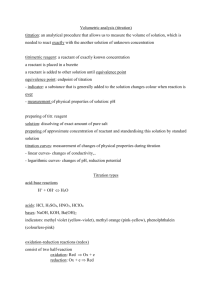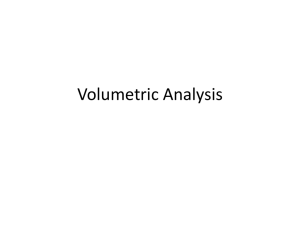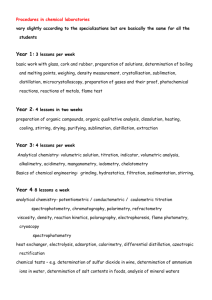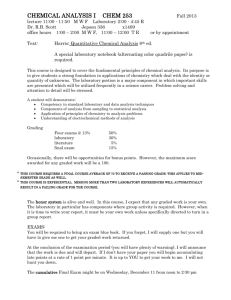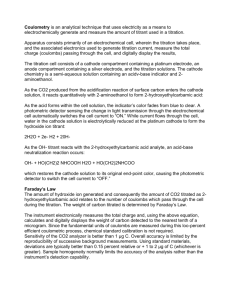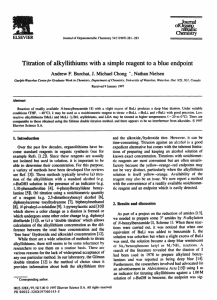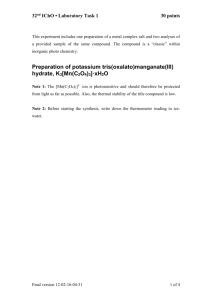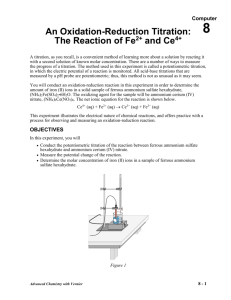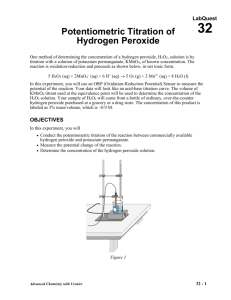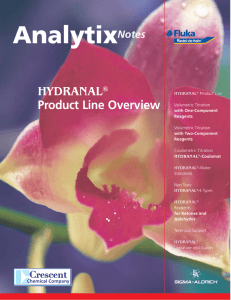Ball State University Chemistry Analysis CHEM 225 Laboratory
advertisement
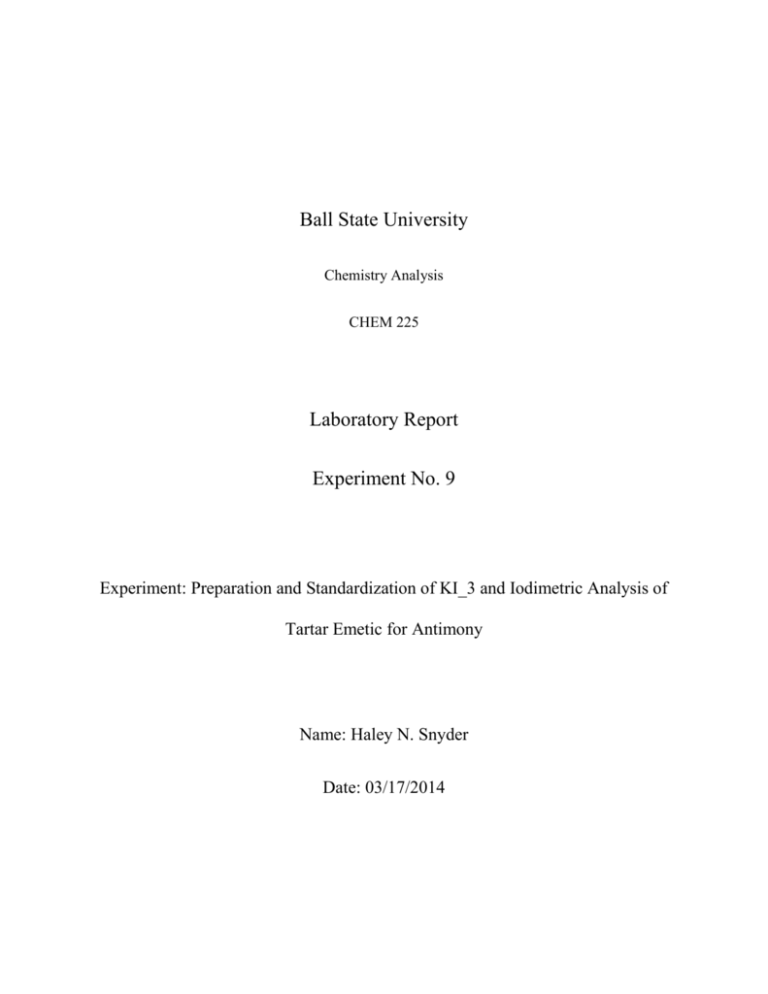
Ball State University Chemistry Analysis CHEM 225 Laboratory Report Experiment No. 9 Experiment: Preparation and Standardization of KI_3 and Iodimetric Analysis of Tartar Emetic for Antimony Name: Haley N. Snyder Date: 03/17/2014 I. Introduction Throughout the procedures of the lab experiment, titrations were performed to analyze known and unknown substances. Experiment I-3 consisted of the titration process a receiving beaker with an iodide solution in order to eventually reach an endpoint of an arsenic solution. I. Procedures The following procedures were performed within the lab: I-3 Preparation and Standardization of N/10 I_3, I-4 Iodiometric Analysis of Tartar Emetic for Antimony. II. Equipment and Reagents I-3 The following equipment and reagents were used within the experiment in addition to the general equipment and tools available in general lab equipment drawers: Iodine reagent grade solid, Potassium Iodide reagent grade solid, N/10 KI_3 solution preparation, Arsenic Trioxide primary standard grade solid, Phenolphthalein indicator solution, Sodium Bicarbonate reagent grade solid, Starch indicator solution. I-4 The following equipment and reagents were used within the experiment in addition to the general equipment and tools available in general lab equipment drawers: Tartar emetic unknown sample, Sodium Potassium Tartrate reagent grade solid, standard N/10 KI_3 solution, Starch indicator solution. III. Data, Graphs and Statistics I-3 The following table represents the resulting volumetric measurement of the three titration trials as well as the calculated results of the molarity of I_3_^-3: g As_2_O_3 0.8002 g mL Iodine 39.9 mL 39.7 mL 39.8 mL Mean: 0.040650 mol Standard Deviation: 1.02x10^-4 Q-Test: 0.500<0.941 (data must be contained) Moles of I_3_^0.040548 mol 0.040752 mol 0.040650 mol I-4 The following table represents the resulting volumetric measurements of the three titration trials as well as the calculated percent antimony present within the unknown (A): g Unknown A 0.7564 g 0.7542 g 0.7544 g Mean: 17.57% mL Iodine 26.7 mL 26.9 mL 26.8 mL % Sb present 17.47% 17.65% 17.58% Standard Deviation: 0.09083 Q-Test: 0.611<0.941 (data must be retained) IV. Discussion Throughout this processes of the experiment, many transfers of substances took place whether it was due to weighing samples on the weighing docs or simply transferring one liquid from one beaker to another flask. However, no matter what was being weighed or measured out, precautionary measures were taken when doing all procedures. I-3 Due to the dark red tint of the titration solution within the first portion of the lab, when analyzing the volumetric measurement on the burette, seeing which lines the meniscus fell on was difficult. With the possibility of not being able to differentiate between 0.1 mL could have resulted in an area of error within the measurement portion of the titration process. The slight error in the measurement of the titration portion could have served as a slight variation of the calculations of the results in molarity. Before beginning with the titrating process, the absolute certainty of all precipitate dissolving was vital before proceeding with the rest of the experiment. The lack of 100% of the precipitate dissolving would later cause a variation in the titration volume measurements which would also cause a variation in the calculations of the molarity. Within this particular experiment, the certainty that all the precipitate was gone was attained. I-4 When adding NaHCO_3 to the receiving beaker solution, watching for bubbles determined when the addition of the substance would cease. With the reliability of human eye to determine when the bubbles had stopped forming within the solution could have served as human error which could have been controlled. The addition of too much NaHCO_3 would alter the resulting titration volumetric measurements after the color change was verified. The dark purple color change was quire sudden and very sensitive to who mush titration solution was added to the receiving beaker solution. The addition of too much titration solution would cause an inaccurate volumetric measurement of how much titration solution was utilized. This as well as the above state processes will also affect the resulting outcome of calculations of the percent antimony present within the unknown sample being analyzed. V. References There were no references used within this lab report other than what was provided within lab as well as the reference to the lab manual for instructions.

